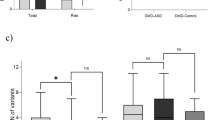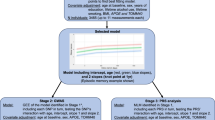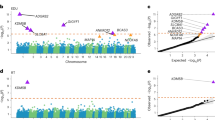Abstract
The aim of our study is to investigate whether single-nucleotide dystrophin gene (DMD) variants associate with variability in cognitive functions in healthy populations. The study included 1240 participants from the Erasmus Rucphen family (ERF) study and 1464 individuals from the Rotterdam Study (RS). The participants whose exomes were sequenced and who were assessed for various cognitive traits were included in the analysis. To determine the association between DMD variants and cognitive ability, linear (mixed) modeling with adjustment for age, sex and education was used. Moreover, Sequence Kernel Association Test (SKAT) was used to test the overall association of the rare genetic variants present in the DMD with cognitive traits. Although no DMD variant surpassed the prespecified significance threshold (P<1 × 10−4), rs147546024:A>G showed strong association (β=1.786, P-value=2.56 × 10−4) with block-design test in the ERF study, while another variant rs1800273:G>A showed suggestive association (β=−0.465, P-value=0.002) with Mini-Mental State Examination test in the RS. Both variants are highly conserved, although rs147546024:A>G is an intronic variant, whereas rs1800273:G>A is a missense variant in the DMD which has a predicted damaging effect on the protein. Further gene-based analysis of DMD revealed suggestive association (P-values=0.087 and 0.074) with general cognitive ability in both cohorts. In conclusion, both single variant and gene-based analyses suggest the existence of variants in the DMD which may affect cognitive functioning in the general populations.
Similar content being viewed by others
Log in or create a free account to read this content
Gain free access to this article, as well as selected content from this journal and more on nature.com
or
References
Hoffman EP, Brown Jr RH . Kunkel LM : Dystrophin: the protein product of the Duchenne muscular dystrophy locus. Cell 1987; 51: 919–928.
Anderson JL, Head SI, Rae C, Morley JW : Brain function in Duchenne muscular dystrophy. Brain 2002; 125: 4–13.
Cotton S, Voudouris NJ, Greenwood KM : Intelligence and Duchenne muscular dystrophy: full-scale, verbal, and performance intelligence quotients. Dev Med Child Neurol 2001; 43: 497–501.
Emery AEH : Duchenne Muscular Dystrophy. Oxford University Press: Oxford; New York, 2003.
Cotton SM, Voudouris NJ, Greenwood KM : Association between intellectual functioning and age in children and young adults with Duchenne muscular dystrophy: further results from a meta-analysis. Dev Med Child Neurol 2005; 47: 257–265.
Sollee ND, Latham EE, Kindlon DJ, Bresnan MJ : Neuropsychological impairment in Duchenne muscular dystrophy. J Clin Exp Neuropsychol 1985; 7: 486–496.
Cyrulnik SE, Fee RJ, De Vivo DC, Goldstein E, Hinton VJ : Delayed developmental language milestones in children with Duchenne's muscular dystrophy. J Pediatr 2007; 150: 474–478.
Wicksell RK, Kihlgren M, Melin L, Eeg-Olofsson O : Specific cognitive deficits are common in children with Duchenne muscular dystrophy. Dev Med Child Neurol 2004; 46: 154–159.
Hinton VJ, De Vivo DC, Nereo NE, Goldstein E, Stern Y : Poor verbal working memory across intellectual level in boys with Duchenne dystrophy. Neurology 2000; 54: 2127–2132.
Hinton VJ, Fee RJ, Goldstein EM, De Vivo DC : Verbal and memory skills in males with Duchenne muscular dystrophy. Dev Med Child Neurol 2007; 49: 123–128.
Mento G, Tarantino V, Bisiacchi PS : The neuropsychological profile of infantile Duchenne muscular dystrophy. Clin Neuropsychol 2011; 25: 1359–1377.
D'Angelo MG, Lorusso ML, Civati F et al: Neurocognitive profiles in Duchenne muscular dystrophy and gene mutation site. Pediatr Neurol 2011; 45: 292–299.
Perronnet C, Vaillend C : Dystrophins, utrophins, and associated scaffolding complexes: role in mammalian brain and implications for therapeutic strategies. J Biomed Biotechnol 2010; 2010: 849426.
Hendriksen JG, Vles JS : Neuropsychiatric disorders in males with duchenne muscular dystrophy: frequency rate of attention-deficit hyperactivity disorder (ADHD), autism spectrum disorder, and obsessive—compulsive disorder. J Child Neurol 2008; 23: 477–481.
Wu JY, Kuban KC, Allred E, Shapiro F, Darras BT : Association of Duchenne muscular dystrophy with autism spectrum disorder. J Child Neurol 2005; 20: 790–795.
Kohane IS, McMurry A, Weber G et al: The co-morbidity burden of children and young adults with autism spectrum disorders. PLoS One 2012; 7: e33224.
Nakamura AMY, Kumagai T, Suzuki Y, Miura K : Various central nervous system involvements in dystrophinopathy: clinical and genetic considerations. No To Hattatsu 2008; 40: 10–14.
Pardo LM, MacKay I, Oostra B, van Duijn CM, Aulchenko YS : The effect of genetic drift in a young genetically isolated population. Ann Hum Genet 2005; 69: 288–295.
Hofman A, Darwish Murad S, van Duijn CM et al: The Rotterdam Study: 2014 objectives and design update. Eur J Epidemiol 2013; 28: 889–926.
Sleegers K, Roks G, Theuns J et al: Familial clustering and genetic risk for dementia in a genetically isolated Dutch population. Brain 2004; 127: 1641–1649.
Liu F, Pardo LM, Schuur M et al: The apolipoprotein E gene and its age-specific effects on cognitive function. Neurobiol Aging 2010; 31: 1831–1833.
Reitan RM : The relation of the trail making test to organic brain damage. J Consult Psychol 1955; 19: 393–394.
Lezak MD, Howieson DB, Loring DW : Neuropsychological Assessment, 4th ed. New York: Oxford University Press, 2004.
Welsh KA, Butters N, Mohs RC et al: The Consortium to Establish a Registry for Alzheimer's Disease (CERAD). Part V. A normative study of the neuropsychological battery. Neurology 1994; 44: 609–614.
Golden CJ : Identification of brain disorders by the Stroop Color and Word Test. J Clin Psychol 1976; 32: 654–658.
Brouwer RW, van den Hout MC, Grosveld FG, van Ijcken WF : NARWHAL, a primary analysis pipeline for NGS data. Bioinformatics 2012; 28: 284–285.
Li H, Durbin R : Fast and accurate short read alignment with Burrows-Wheeler transform. Bioinformatics 2009; 25: 1754–1760.
Li H, Handsaker B, Wysoker A et al: The Sequence Alignment/Map format and SAMtools. Bioinformatics 2009; 25: 2078–2079.
McKenna A, Hanna M, Banks E et al: The Genome Analysis Toolkit: a MapReduce framework for analyzing next-generation DNA sequencing data. Genome Res 2010; 20: 1297–1303.
Aulchenko YS, Ripke S, Isaacs A, van Duijn CM : GenABEL: an R library for genome-wide association analysis. Bioinformatics 2007; 23: 1294–1296.
Li J, Ji L : Adjusting multiple testing in multilocus analyses using the eigenvalues of a correlation matrix. Heredity (Edinb) 2005; 95: 221–227.
Wu MC, Lee S, Cai T, Li Y, Boehnke M, Lin X : Rare-variant association testing for sequencing data with the sequence kernel association test. Am J Hum Genet 2011; 89: 82–93.
Consortium TG : The Genotype-Tissue Expression (GTEx) project. Nat Genet 2013; 45: 580–585.
Voyer D, Voyer S, Bryden MP : Magnitude of sex differences in spatial abilities: a meta-analysis and consideration of critical variables. Psychol Bull 1995; 117: 250–270.
Lord C, Rutter M, Goode S et al: Autism diagnostic observation schedule: a standardized observation of communicative and social behavior. J Autism Dev Disord 1989; 19: 185–212.
Caron MJ, Mottron L, Berthiaume C, Dawson M : Cognitive mechanisms, specificity and neural underpinnings of visuospatial peaks in autism. Brain 2006; 129: 1789–1802.
Shah AFU : Why do autistic individuals show superior performance on the block design task? J Child Psychol Psychiatry 1993; 34: 1351–1364.
Pagnamenta AT, Holt R, Yusuf M et al: A family with autism and rare copy number variants disrupting the Duchenne/Becker muscular dystrophy gene DMD and TRPM3. J Neurodev Disord 2011; 3: 124–131.
Chung RH, Ma D, Wang K et al: An X chromosome-wide association study in autism families identifies TBL1X as a novel autism spectrum disorder candidate gene in males. Mol Autism 2011; 2: 18.
Pellicano E, Maybery M, Durkin K, Maley A : Multiple cognitive capabilities/deficits in children with an autism spectrum disorder: ‘weak’ central coherence and its relationship to theory of mind and executive control. Dev Psychopathol 2006; 18: 77–98.
Ropar D, Mitchell P : Susceptibility to illusions and performance on visuospatial tasks in individuals with autism. J Child Psychol Psychiatry 2001; 42: 539–549.
Rumsey JM, Hamburger SD : Neuropsychological findings in high-functioning men with infantile autism, residual state. J Clin Exp Neuropsychol 1988; 10: 201–221.
Happe F, Frith U : The weak coherence account: detail-focused cognitive style in autism spectrum disorders. J Autism Dev Disord 2006; 36: 5–25.
Muntoni F, Torelli S, Ferlini A : Dystrophin and mutations: one gene, several proteins, multiple phenotypes. Lancet Neurol 2003; 2: 731–740.
Lidov HG, Byers TJ, Watkins SC, Kunkel LM : Localization of dystrophin to postsynaptic regions of central nervous system cortical neurons. Nature 1990; 348: 725–728.
Sekiguchi M, Zushida K, Yoshida M et al: A deficit of brain dystrophin impairs specific amygdala GABAergic transmission and enhances defensive behaviour in mice. Brain 2009; 132: 124–135.
Kueh SL, Head SI, Morley JW : GABA(A) receptor expression and inhibitory post-synaptic currents in cerebellar Purkinje cells in dystrophin-deficient mdx mice. Clin Exp Pharmacol Physiol 2008; 35: 207–210.
Vaillend C, Billard JM : Facilitated CA1 hippocampal synaptic plasticity in dystrophin-deficient mice: role for GABAA receptors? Hippocampus 2002; 12: 713–717.
Fritschy JM, Schweizer C, Brunig I, Luscher B : Pre- and post-synaptic mechanisms regulating the clustering of type A gamma-aminobutyric acid receptors (GABAA receptors). Biochem Soc Trans 2003; 31: 889–892.
Craig AM, Kang Y : Neurexin-neuroligin signaling in synapse development. Curr Opin Neurobiol 2007; 17: 43–52.
Mohler H : Role of GABAA receptors in cognition. Biochem Soc Trans 2009; 37: 1328–1333.
Millan MJ, Agid Y, Brune M et al: Cognitive dysfunction in psychiatric disorders: characteristics, causes and the quest for improved therapy. Nat Rev Drug Discov 2012; 11: 141–168.
Holder E, Maeda M, Bies RD : Expression and regulation of the dystrophin Purkinje promoter in human skeletal muscle, heart, and brain. Hum Genet 1996; 97: 232–239.
Gorecki DC, Monaco AP, Derry JM, Walker AP, Barnard EA, Barnard PJ : Expression of four alternative dystrophin transcripts in brain regions regulated by different promoters. Hum Mol Genet 1992; 1: 505–510.
Daoud F, Angeard N, Demerre B et al: Analysis of Dp71 contribution in the severity of mental retardation through comparison of Duchenne and Becker patients differing by mutation consequences on Dp71 expression. Hum Mol Genet 2009; 18: 3779–3794.
Taylor PJ, Betts GA, Maroulis S et al: Dystrophin gene mutation location and the risk of cognitive impairment in Duchenne muscular dystrophy. PLoS One 2010; 5: e8803.
Aartsma-Rus A, Van Deutekom JC, Fokkema IF, Van Ommen GJ, Den Dunnen JT : Entries in the Leiden Duchenne muscular dystrophy mutation database: an overview of mutation types and paradoxical cases that confirm the reading-frame rule. Muscle Nerve 2006; 34: 135–144.
Miyake A, Friedman NP, Rettinger DA, Shah P, Hegarty M : How are visuospatial working memory, executive functioning, and spatial abilities related? A latent-variable analysis. J Exp Psychol 2005; 130: 532–545.
Salthouse T : Relations between cognitive abilities and measures of executive functioning. Neuropsychology 2005; 19: 532–545.
Ladouceur M, Dastani Z, Aulchenko YS, Greenwood CM, Richards JB : The empirical power of rare variant association methods: results from sanger sequencing in 1998 individuals. PLoS Genet 2012; 8: e1002496.
Li B, Leal SM : Methods for detecting associations with rare variants for common diseases: application to analysis of sequence data. Am J Hum Genet 2008; 83: 311–321.
Madsen BE, Browning SR : A groupwise association test for rare mutations using a weighted sum statistic. PLoS Genet 2009; 5: e1000384.
Acknowledgements
Erasmus Rucphen Family study: The ERF study as a part of EUROSPAN (European Special Populations Research Network) was supported by European Commission FP6 STRP grant number 018947 (LSHG-CT-2006-01947) and also received funding from the European Community's Seventh Framework Program (FP7/2007–2013)/grant agreement HEALTH-F4-2007-201413 by the European Commission under the program ‘Quality of Life and Management of the Living Resources’ of 5th Framework Program (no. QLG2-CT-2002-01254). High-throughput analysis of the ERF data was supported by joint grant from Netherlands Organization for Scientific Research and the Russian Foundation for Basic Research (NWO-RFBR 047.017.043). Exome sequencing analysis in ERF was supported by the ZonMw grant (project 91111025). We are grateful to all study participants and their relatives, general practitioners and neurologists for their contributions and to P Veraart for her help in genealogy, J Vergeer for the supervision of the laboratory work and P Snijders for his help in data collection. Dina Vojinovic is supported by the Ministry of Science of Serbia (grant number 175083). Najaf Amin is supported by the Hersenstichting Nederland (project number F2013(1)-28).
Rotterdam study: The generation and management of GWAS genotype data for the Rotterdam Study are supported by the Netherlands Organisation of Scientific Research NWO Investments (nr. 175.010.2005.011 and 911-03-012). This study is funded by the Research Institute for Diseases in the Elderly (014-93-015; RIDE2), the Netherlands Genomics Initiative (NGI)/Netherlands Organisation for Scientific Research (NWO) project nr. 050-060-810 and Netherlands Consortium for Healthy Ageing (NCHA). We thank Pascal Arp, Mila Jhamai, Marijn Verkerk, Lizbeth Herrera and Marjolein Peters for their help in creating the GWAS database, and Karol Estrada and Maksim V Struchalin for their support in creation and analysis of imputed data. The Rotterdam Study is funded by Erasmus Medical Center and Erasmus University, Rotterdam, Netherlands Organization for the Health Research and Development (ZonMw), the Research Institute for Diseases in the Elderly (RIDE), the Ministry of Education, Culture and Science, the Ministry for Health, Welfare and Sports, the European Commission (DG XII), and the Municipality of Rotterdam. We are grateful to the study participants, the staff from the Rotterdam Study and the participating general practitioners and pharmacists.
Author information
Authors and Affiliations
Corresponding author
Ethics declarations
Competing interests
The authors declare no conflict of interest.
Additional information
Supplementary Information accompanies this paper on European Journal of Human Genetics website
Supplementary information
Rights and permissions
About this article
Cite this article
Vojinovic, D., Adams, H., van der Lee, S. et al. The dystrophin gene and cognitive function in the general population. Eur J Hum Genet 23, 837–843 (2015). https://doi.org/10.1038/ejhg.2014.183
Received:
Revised:
Accepted:
Published:
Issue date:
DOI: https://doi.org/10.1038/ejhg.2014.183
This article is cited by
-
Computational cognitive modeling and validation of Dp140 induced alteration of working memory in Duchenne Muscular Dystrophy
Scientific Reports (2020)
-
Variants in TTC25 affect autistic trait in patients with autism spectrum disorder and general population
European Journal of Human Genetics (2017)



